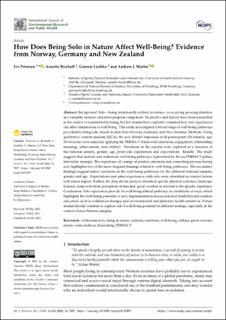| dc.identifier.citation | Petersen, E., Bischoff, A., Liedtke, G., & Martin, A. J. (2021). How Does Being Solo in Nature Affect Well-Being? Evidence from Norway, Germany and New Zealand. International Journal of Environmental Research and Public Health, 18(15), Artikkel 7897. | en_US |
| dc.description.abstract | Background: Solo—being intentionally solitary in nature—is receiving growing attention as a valuable outdoor education program component. Its practice and history have been researched in the context of experiential learning, but few studies have explicitly examined how solo experiences can affect dimensions of well-being. This study investigated a broad range of well-being pathways provided by being solo, based on data from Norway, Germany, and New Zealand.
Methods: Using qualitative content analysis (QCA), the solo debrief responses of 40 participants (26 females, age: 19–64 years) were analysed, applying the PERMA-V framework (emotions, engagement, relationship, meaning, achievement, and vitality). Variations in the reports were explored as a function of the national sample, gender, age, prior solo experiences and expectations.
Results: The study suggests that hedonic and eudemonic well-being pathways, represented by the six PERMA-V pillars, interrelate strongly. The experience of a range of positive emotions and connecting process during solo highlights two of the most frequent findings related to well-being pathways. The secondary findings suggest minor variations in the well-being pathways for the different national samples, gender and age. Expectations and prior experiences with solo were identified as context factors with minor impact. Further, the data-driven analysis identified specific physical activities, landscape features, sense-activation, perception of time and ‘good’ weather as relevant to the specific experience.
Conclusions: Solo experiences provide for well-being-related pathways in a multitude of ways, which highlights the well-being potential of solo implementation across practical fields beyond outdoor education, such as wilderness therapy, and environmental and planetary health initiatives. Future studies should continue to explore solo’s well-being potential in different settings, especially in the context of non-Western samples. | en_US |

